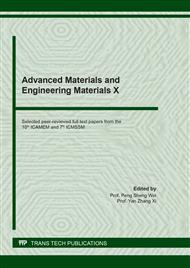p.322
p.329
p.334
p.339
p.344
p.350
p.358
p.363
p.369
Research on Control Factors and Performance of YAG Porous Ceramics
Abstract:
In this paper, the YAG powder is prepared by the co-precipitation method. In addition, the sintering aid to aid sintering and the high temperature foaming agent that becomes gas released during the heating process so that the sample has pores, the ball mill mixes the material, and the sample press is extruded. Box-type resistance furnace sintering. Through this process, porous ceramics can be made. Study the effect of sintering aid content, foaming agent type, sintering temperature on the properties of YAG porous materials. The analysis and discussion can lead to the following conclusions: as the content of sintering aid silica in the sample increases, the sintering temperature of the sample decreases. It is best when the ratio of sintering aid alumina to silica is 3:1. The moldability of the sample whose foaming agent is wood chips is worse than that of the sample whose foaming agent is fiber and carbon powder. The ratio of sintering aid alumina to silica is 3:1, and the sintering temperature of the sample with carbon powder as the blowing agent is best when the sintering temperature is 1400 °C.
Info:
Periodical:
Pages:
344-349
Citation:
Online since:
November 2021
Authors:
Keywords:
Price:
Сopyright:
© 2021 Trans Tech Publications Ltd. All Rights Reserved
Share:
Citation:


